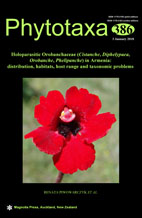Abstract
The species of holoparasitic genera from the family Orobanchaceae have a specific lifestyle associated with the host, greatly reduced vegetative organs, very variable features and quickly lose their color, resulting in difficulties and mistakes in identification. This study represents the first comprehensive monograph of 36 species from the four holoparasitic genera, Cistanche, Diphelypaea, Phelipanche and Orobanche (Orobanchaceae), in Armenia. This country, as a part of the Caucasus, is one of the most important biodiversity centers in the world, a diversity which includes rich and insufficiently understood holoparasitic plants. Our investigations were based on five years of field work in the Caucasus, and complemented by examination of ca. 1200 herbarium sheets with ca. 3000 specimens from 37 herbaria. We present information on distribution, list of localities, habitat, phenology, host range, taxonomic clarification, illustrations and descriptions for problematic ones, images from the field, proposals for new synonymisations, new combination Phelipanche cernua subsp. sinaica (Beck) Piwow., Ó. Sánchez & Moreno Mor., 20 lectotypes, two epitypes, one neotype are designated here, as well as a key and geospatial conservation assessments for all species based on IUCN criteria.

